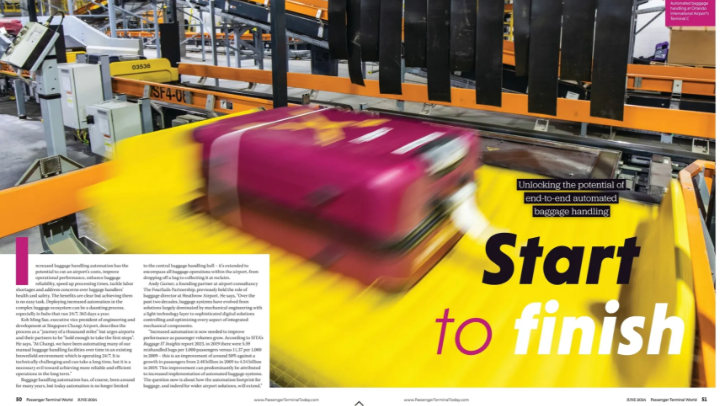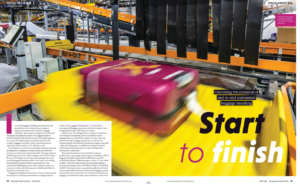Koh Ming Sue, executive vice president of engineering and development at Changi Airport Group, speaks with Passenger Terminal Today to reveal more about the airport’s increasingly automated baggage handling system
Why is automation needed in the end-to-end baggage handling system?
The key imperative for having to automate the airport’s baggage handling system was manpower constraints, in terms of the ability to continue to attract locals to work 24/7 in the harsher baggage handling environment. Additionally, governments are tightening foreign labor quotas for manual jobs. Alongside this, labor costs are rapidly rising.
Another driver is the operational challenges caused by weather elements. Due to climate change, storms and periods of lightning hazards may become more frequent and intense, posing a danger to baggage handling personnel working outside on the open-air aircraft parking aprons. Overall, baggage handling technology has matured to a stage where smart machines can operate much more safely, reliably and cost-effectively than manpower.
What does the ultimate automated end-to-end baggage journey look like?
Ideally, this would be a ‘man-less’ process whereby bags checked in by passengers are screened and moved by systems and autonomous machines from the airport terminal to the aircraft and vice versa. It would be monitored centrally by a small team of duty personnel, through a digital twin dashboard, who would intervene only in exceptional circumstances (e.g. equipment breakdown).
What are the main benefits of automating the end-to-end baggage journey (operational performance, reliability, passenger experience, etc)?
Some of the key benefits envisaged would include greater consistency of performance; safer operations; less vulnerability to weather disruptions; more intelligent prioritization in the handling of urgent transfer bags through collaborative bag data exchange across upstream and downstream airports; fewer human errors; smarter pooling and management of infrastructure resources to boost peak period handling capacity; more sustainable cost trajectory; higher value-add job offers; better workplace environment for personnel; higher operational visibility for airlines; and a more customized and friendly experience for passengers.
How automated is Changi Airport’s current baggage handling system?
With the wider adoption of self-service check-in and self-bag-drop, Changi Airport has been able to automate the current baggage handling system all the way from the moment a passenger divests his check-in luggage to the point where it is conveyed to its departure flight. This includes the point where the bag is screened at security, the bag’s sortation to an outbound racetrack, as well as the ground handler inducting a transfer bag that is just offloaded from an arrival flight. The segment not yet automated is the offloading of bags and baggage containers from aircraft. The process of trucking bags to the airport terminal for processing and vice versa also needs to be automated.
What are some of the key challenges when it comes to automating the end-to-end baggage journey? Can you share any examples from Changi Airport’s experience?
In striving toward ‘man-less’ baggage handling, there is no off-the-shelf solution in terms of ready products or proven concepts of operations. Thus we need to start with a clean slate to brainstorm ideas, test assumptions and capabilities in well-formulated stages and develop viable business models to realize this end goal. Another challenge along this evolutionary journey is the interim period of having smart machines operating together with people in the same environment. While machines can share intent and communicate coordinating commands seamlessly in real time, people working in the same tight spaces would still sometimes have to judge the machine’s next move and vice versa. The interfacing details of how one machine hands over the bag or baggage container to another machine also can’t be taken for granted. The logistics of having to automatically store, sort and convey empty aircraft baggage containers to fit the needs of the baggage sortation system is also spatially demanding, especially for brownfield sites.
Plus, there is the need to design a complete, sustainable environment for the machines to function continually. For example, they must coordinate self-charging when their battery energy levels are low. This is no mean feat and can amount to sizable costs over the span of multiple experiments and reliability-proving cases. To invent machines that have the dexterity of human hands and legs, the vision of human eyes in all weather and light conditions, the cognition for their complex operating environments – all while being failsafe – would need a considerable incubation period and investment.
How important is collaboration with airport stakeholders?
Currently, the process of and responsibilities for baggage handling can be rather fragmented in airports so the collaboration of multiple parties is absolutely essential. Stakeholders can range from airlines embracing common self-service check-in and self-bag-drop, security authorities’ acceptance of bag screening procedures, airport terminal operators’ automation of baggage sortation systems, ground handlers’ involvement in accounting for and conveyance of bags into and out of aircraft, etc. It is a process chain where each stakeholder has to play a dovetailing role for effective transformation to happen. This may involve shifts of value allocation across the chain for global optimization.
What new technologies and solutions (robotics, AVs, etc) are available for increased automation and how are these being deployed?
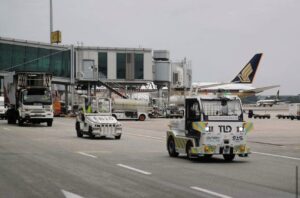
The advent of high-power-density and fast-actuating robot arms enables nimble loading and off-loading of luggage pieces of different types (e.g. soft or hard cases, fragile or hardy items, varying textures of bag surface materials, etc) in very tight spaces. This includes movements in and out of oddly shaped aircraft baggage containers. These developments can achieve this without compromising on storage efficiency. The availability of autonomous tractors/trolleys and individual bag or tub carriers also offer a ‘man-less’ means of conveyance for different baggage handling functions. Further, a digital dashboard that can offer real-time and, if possible, predictive planning and smart coordination of baggage handling operations and maintenance functions across the airport would also contribute to the mission.
What future technologies or developments do you see accelerating the automation of the end-to-end baggage journey?
The rise of artificial intelligence (AI) software and faster processing hardware (quantum computing), more versatile human-like robots and machine learning (ML) through big data analytics for continuous self-learning and improvement would propel the outcome of baggage handling automation to even greater heights over time.
How are baggage operators’ roles changing as baggage handling becomes increasingly automated? Are working conditions improved with increased automation? If yes, how?
Baggage handling workers, as with all laborers who used to perform repetitive and manual tasks, would have to upskill themselves over time to catch up with the technological transformation of their job functions. Instead of doing exhausting hard work like carrying bags, they would need to switch to performing specific tasks that machines have yet to take over, including operations monitoring and management, and also serving as backup resources in case of major equipment or system outages. Where capable, they should also acquire basic skills in software systems, hardware equipment or robot upkeeping, maintenance and repair tasks, which should involve working in a more conducive workshop environment with higher pay.
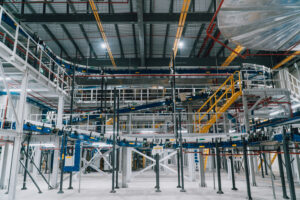
How can automation increase sustainability within the baggage handling system?
Against rising manpower costs over time, automation should enable baggage handling functions to be delivered in a more cost-sustainable manner in due course. The application of smart algorithms in systems control would enable machines to operate more energy-efficiently, infrastructure resources to be more optimally utilized, and operations to be carried out undisrupted over a wider range of weather conditions. Additionally, with green energy sources, all this automation would contribute to enhancing the sustainability of airport operations.
What are the key areas or bottlenecks that are yet to be automated (first or last mile, for example)? How do you see these areas being automated in the future?
The main areas of automation gaps are the handling of aircraft baggage containers in a space-constrained baggage handling environment; the loading and offloading of bags into/out of aircraft baggage containers and trolleys at the airport terminal end; the conveyance of such containers and/or trolleys between the airport terminal and the aircraft; and the loading and offloading of aircraft containers and loose bags into/out of the aircraft hold. The experiments mentioned in the pointers above illustrate some of our ongoing endeavors to automate these functions.
Will baggage handling workers still be needed in a fully automated end-to-end baggage system?
Foreseeably, when baggage handling automation becomes more mature in due time, a large part of baggage handling workers could be avoided. However, workers (likely on a multi-tasking basis) would still be needed for standby in case of a system outage, and new teams of technical staff would be needed round the clock to operate and maintain the machines and related automated systems to keep them functioning reliably.
Can automation easily be added to existing baggage handling systems, or should systems be designed from the ground up to ensure the most efficient end-to-end baggage handling system?
Ideally, systems designed ground-up from a greenfield airport terminal plan would generate more transformative added value and efficiency without the encumbrance of existing spatial and infrastructural constraints. However, greenfield developments are few and far between. Thus, most airports would have to make the best use of their existing conditions by modifying infrastructure in situ to reap the fruits of automation as far as practicable.
How can automation be retrofitted to existing baggage handling solutions?
In Changi Airport, we have been automating many of our more manual baggage handling facilities over time in an existing brownfield airport operating 24/7. It is technically more challenging and can take a longer time to realize the outcome but is a necessary evil for creating more reliable and efficient operations for the longer term.
What failsafe mechanisms can be built into automated baggage handling systems to ensure that passengers still receive their bags on time even if the technology breaks down?
In our design considerations, Murphy’s Law is always respected – what can fail is assumed will fail. Thus, redundancy provisions and fallback operating procedures have to be well thought out and provided for on day one. This ensures that any single failure would not cripple baggage handling operations. For example, if the data link from airlines is lost, the system should still let bag tags be automatically read by intelligent barcode scanners and/or smart cameras, so that bags inducted into the system can still be processed and conveyed to their intended destinations.
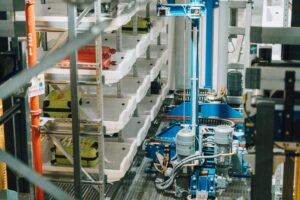
Credit: Changi Airport
What investments has Changi Airport recently made in automating its end-to-end baggage handling system, and are any future developments in this area planned?
Examples include testing the use of autonomous baggage tractors to truck aircraft baggage containers and trolleys automatically between the airport terminal and aircraft; assisted loading and offloading of loose luggage both at the aircraft end and at the airport terminal end; as well as predictive operations and maintenance of baggage handling systems through the use of smart motors and digital twin dashboards, etc.
For more top insights into Changi Airport’s end-to-end automated baggage handling operations, read Passenger Terminal World’s BHS feature here.

